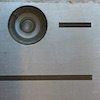Microbalance
Introduction
This document outlines prudent procedures when using the microbalances and associated space. While the micro balances are expensive, probably of more concern to you is the possibility for contamination of your samples. Please be exceptionally clean when working with and near the micro balances.
Contamination Avoidance
Contamination is defined as foreign material mistakenly included in with sample or standard material. If the contaminant has nitrogen, carbon, or sulfur, it will affect your isotope measurements. For example, ethanol has carbon and might contaminate your carbon isotope measurement. Kim wipes are mostly cellulose which contains carbon. Airborne dust could contain nitrogen, carbon, and sulfur especially if you are blowing the balance area clean of someone's spilled bottle of reference materials. The marble table contains carbon.
- Keep utensils wiped clean before and after weighing session as well as in between samples
- If you choose to use an alcohol to keep your untensils clean, make certain the alcohol has completely evaporated before using the utensil
- Make certain that the utensil is free of paper from the paper towel / wipe
- Keep balance tray free of material
- If you spill, see troubleshooting section below for proper cleaning
- Keep the tin / silver capsule container lid CLOSED unless you are actively removing a capsule
- Keep sample trays clean by either throwing away grossly contaminated trays or by using air pressure to blow out debris
- Keep sample / standard bottles CLOSED unless you are actively removing material
- Keep the balance door closed when not transferring materials in and out
Inaccurate Mass Measurements


Inaccurate mass measurements will occur if the balance is not properly zeroed, is not level, has a door ajar, or if material is on the weighing surface and is not cleaned off. Inaccurate mass measurements will not necessarily contaminate your capsule as described above, but they will result in poor percent carbon, nitrogen, sulfur, or carbonate estimates.
- Make certain the balance is clean, level, and zeroed.
- Make certain all the material from your utensil makes it into the capsule and that it is not spilled onto the weighing surface.
- If material is spilled onto the weighing plate while attempting a measurement, remove the capsule and clean the plate. Then, try to reposition the capsule for another measurement.
Weighing Samples
- Make sure the balance is on a few minutes before trying to weigh.
- Make sure the balance is level as indicated by the bubble.
- Choose a utensil appropriate for your work and clean it.
- Choose capsules appropriate for your samples size and material.
- Tare the balance with the capsule on the tray and balance door closed.
- Remove the capsule from the balance, add material, place it back in the balance, close the door, and wait for the mass measurement to display.
- Write down the mass.
- Weighing for shrek?
- Remove the capsule and ball it up into a nice tight ball or cube.
- Make the ball as smooth as possible and avoid sharp edges. This ensures the sample will fall properly into the elemental analyzer.
- Consider putting the balled up tin and sample back into the balance to verify you have the same weight you think you should have.
- Put the balled up sample and capsule into tray.
- Weighing for the kiel?
- Use the aluminum weigh boats instead of capsules.
- Tip the boat, but keep holding onto it, such that the powder drops into the glass vessel.
- Put the weigh boat back on the balance to ensure it returns to 0.000 mg.
Cleanup
- Wipe down all utensils used.
- Return standards to desiccator.
- Make certain balance is free of material and door is closed.
- Wipe down marble table.
- Put away pens, utensils, etc.
- Make certain the entire area is very clean and organized before you leave.
Troubleshooting
Spilled material onto the balance
- DO NOT use compressed air to blow material from within the enclosed space. Always remove the weighing plate before attempting to clean it.
- Make certain, while cleaning the balance, that you NEVER allow debris to fall into the hole where the weighing plate rests.
- Left balance – open door, remove tray, wipe down inside of balance with wipe, wipe down tray, reassemble
- Right balance – remove glass top, use tray removal tool located in drawer on left side of XS3DU box, remove collar and tray, wipe off, reassemble
Balance won’t stabilize
- If the balance keeps drifting in one direction, it could be that your sample is either wet and drying out or dry and absorbing water.
- If no sample is on the tray and it's drifting, it could be the atmospheric pressure changing rapidly or the building circulation changing rapidly.
